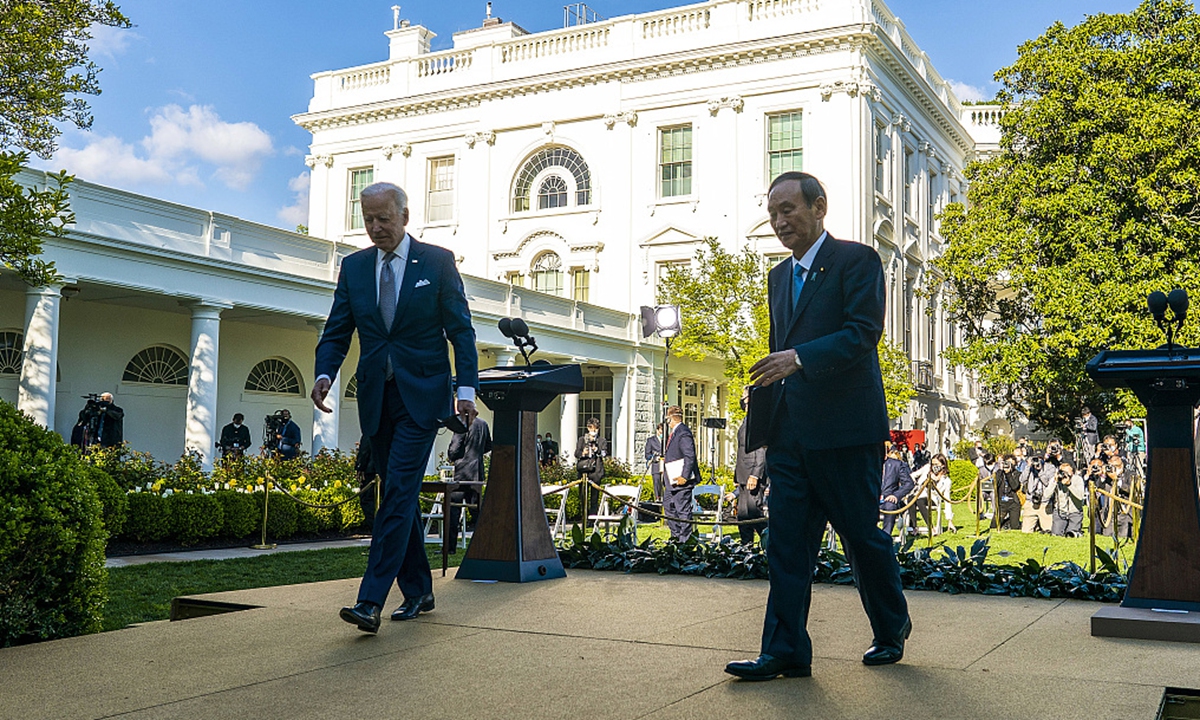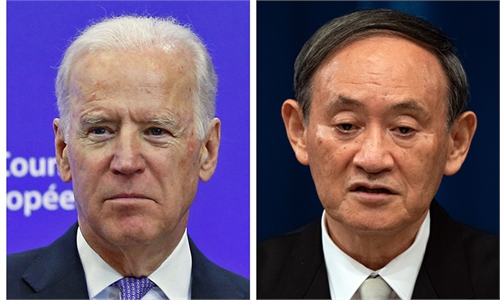5G alliance between US and Japan 'doomed to fail'
‘Self-sufficiency’ needed for Chinese chipmakers

US President Joe Biden (left) and Japanese Prime Minister Yoshihide Suga leave the Rose Garden at the conclusion of a news conference at the White House on Friday in Washington, DC.:VCG
The renewed alliance between the US and Japan to take on China in 5G is an "unrealistic illusion" that is doomed to fail, given Chinese companies' wide-ranging presence in 5G infrastructure and its huge domestic application market, experts said on Sunday, noting that this reflects the pair's struggle in the crowded industry.
US President Joe Biden and Japanese Prime Minister Yoshihide Suga on Friday (US time) renewed and escalated their moves against China's 5G network development by showcasing their shared resolve to ensure the so-called "security and openness" of 5G wireless networks and concurring that it is important to rely on "trustworthy vendors." Although they did not specifically mention China in their joint statement, the subtext was clearly to contain China's development in 5G technologies.
Experts said that Japan's hasty move to side with the US in containing China is just a showcase of its political stance, and the narrow cooperation is unlikely to yield material results for Japan's 5G presence globally.
According to their joint statement posted on the White House website, the US and Japan have agreed to "advance secure and open 5G networks, including Open Radio Access Networks, by fostering innovation and by promoting trustworthy vendors and diverse markets."
The two will jointly invest in research, development, testing, and deployment of secure networks and advanced ICT including 5G and next-generation mobile networks ("6G" or "Beyond 5G"), with the US having committed $2.5 billion to this effort, and Japan $2 billion.
"The US-Japan alliance in 5G cooperation and even 6G is wishful thinking from the perspective of research and development (R&D) investment," Xiang Ligang, director-general of the Beijing-based Information Consumption Alliance, told the Global Times on Sunday. The allies' planned total investment of $4.5 billion is far less than Huawei's annual R&D spending of over 100 billion yuan ($15.34 billion), he said.
Meanwhile, the US and Japan are disadvantaged in terms of technological accumulation and markets large enough for applications, Xiang said, noting that their undesirable performance in the 5G race may be a sign of their competitiveness in the 6G race.
Chinese telecommunications equipment makers, led by Huawei and ZTE, account for about 40 percent of the 5G stations worldwide, and Europe's Ericsson and Nokia, as well as South Korea's Samsung, also take significant shares. Meanwhile, the US and Japan have apparently fallen behind in the 5G global race, Nikkei reported.
As for the potential impact on China's 5G presence overseas, Jiang Junmu, a Shanghai-based veteran industry expert, told the Global Times that the situation can't get any worse, as the US persuaded other countries to exclude Huawei during the Trump administration.
It's worth noting that the US-Japan joint statement stressed cooperation on sensitive supply chains, including semiconductors, and on the promotion and protection of critical technologies. There has been speculation that the US may ask Japan to follow its export control regulations against China.
Jiang said that Japan has a dominant position in chip materials and equipment, and if the two impose a coordinated set of sanctions against China, not only Chinese companies but the entire global semiconductor supply chain will sustain collateral damage.
However, Jiang stressed that Japanese companies will be neither willing nor able to abandon the huge Chinese market.
Japanese semiconductor material manufacturer Ferrotec is speeding up the expansion of production in China, with the help of China's semiconductor location policy, Nikkei's Chinese website reported on March 25. It said the company has raised about 4.17 billion yuan since 2020, and the funds will be mainly used for mass production of 12-inch wafer products in China, despite China-US friction.
In a sign of a further crackdown on China's chip sector, Reuters reported on Thursday that US Representative Michael McCaul and Senator Tom Cotton recently called for a requirement that the US licenses to sell semiconductors made abroad with US technology to Huawei be extended to any Chinese company designing more advanced chips at the scale of 14 nanometers or less.
"This sent a stark warning to domestic semiconductor companies about the urgency of complete domestic replacement," Xiang said, noting that domestic companies need to build a self-sufficient chip industry chain, ranging from design software to lithography machine technology to raw materials.
The biggest challenge is mass production of chips at 14-nm or less. It will take years for domestic chip firms to realize that scale, but it's a task that must get started now, he stressed.

